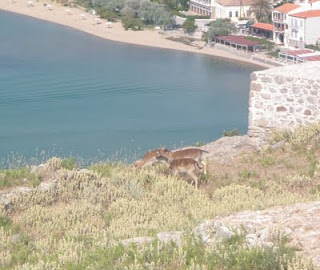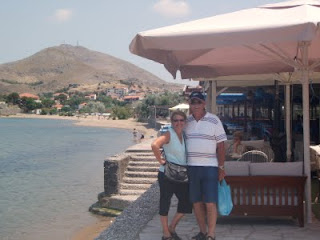The Northern Sporades group consists of about eight main islands, with numerous other islets. We spent just four nights there as we needed to keep moving to Chalkis on Evia Is about 85NM away, where we would meet the Naiad technician. This short visit gave us the chance to scope out the N Sporades for our longer visit next month with Sharon & Doug.
One late afternoon we anchored off a fantastic sandy beach on the small uninhabited nature reserve islet of Nissos Tsoungria. Lush green forest came right down to the beach, and the islet was deserted except for a great little rustic taverna on the shore with home-built tables and chairs, and fern leaves over a makeshift frame to provide shelter from the sun. The staff don’t live there, but when the last patron leaves they go home to Skiathos each night on their fishing boat. They just lock everything up, and leave it all unattended. Can you imagine doing that in New Zealand?
Envoy anchored off Nisos Tsoungria

The great taverna on Nisos Tsoungria

We watched the sunset, and spent the night sharing the bay with three sailing yachts and a high-powered six metre RIB, the occupants of which were camping ashore. We had a tranquil night, with just enough motion to remind us we were anchored off an exposed beach.
In the morning I went up to the pilothouse, and noticed that one of the yachts had departed – but not very far, as 200m away she was stuck fast on an underwater reef that protruded out from the end of the bay. The yacht was a Beneteau 385 sloop, flying the Greek flag, and with 3 people aboard. I watched for a few minutes, and nothing was happening except one of the occupants was in the water checking the depths around the hull.
The yacht Bonnie aground on a reef

There was no swell, and there is virtually no tide here. My Coastguard training kicked-in, and I jumped in our small dinghy, and went over to see if I could help.
The skipper’s wife spoke some English, and it was apparent they had little idea what to do, although he was able to tell me that only the keel was aground, they were not taking water, and the deepest water was astern. I suggested that I take the skipper ashore to ask the owner of the six metre RIB for assistance to tow him off, and to ask the skipper of a nearby Greek yacht to lend a hand with his large dinghy by tilting the Beneteau over using a halyard attached to the top of the mast. This would lessen the yacht’s draught, and make it easier to free from the reef. The owner of the RIB was only too happy to help (after we’d woken him up), but the other skipper didn’t want to know. Consequently we used our own small RIB with the 2.3HP Honda to tilt the yacht over, and were surprised how little power was needed with the amount of leverage provided by the line to the halyard. On the second attempt the RIB slowly pulled the Beneteau off the reef and was able to tow her to deeper, safe water.
The RIB takes the strain - you can see the reef under the water in foreground

After the skipper checked that there was little damage apart from scrapes to the keel, and to his pride, he gave us a bottle of Greek chardonnay for our help. In NZ & Australia we’re so lucky to have Coastguard to assist us out of boating mishaps, and at negligible cost. The Coastguard here is much more concerned about enforcement, people/arms/drug smuggling, and anti-terrorism than in providing assistance, although they are responsible for SAR at sea.
TECHNICAL
On 18 July Wim Verkoelen, a Naiad engineer based in Holland, visited us in Chalkis, about an hour’s drive north of Athens airport. With him were two engineers from Naiad’s Greek agents. Wim brought with him a new Control Unit (cost Euro 1,881 or about NZ$3,400), and a Display Panel – both of which had been tested and were working well.
It’s great to see a talented and knowledgeable guy like Wim at work, and within about two hours he had checked the whole system over and installed the new Control Unit. We did a sea trial, and everything seemed to be working OK I only say “seems” because where we are currently the sea state is very flat, and there was no chance to test the system in waves. Wim found there were some errors made by the Turkish agent’s staff during re-assembly of the system after they changed the seals for the fins, one wrong polarity possibly causing the failure of our own Control Unit. Since then we’ve used the Naiads for about 20 hours and all is well so far. We’ve yet to encounter any waves above about half a metre to really test them, but inevitably will.
Wim from Naiad Holland (3rd from left)fixed our stabilisers - I'm smiling

I forgot to mention that a couple of weeks ago we had a fresh water leak into the bilges. I was talking with Kevin in the pilothouse, and noticed the amp meter was running a bit high, there were no lights on, and there were no faucets open, but when I switched off the fresh water pump breaker the amps dropped. It turned out that the outlet hose from the fresh water pump had come off the inlet to the water filter. If this had happened at anchor we would have heard the water pump running, but under way we can’t hear the fresh water pump. It was a simple matter to re-connect, and shows the importance of keeping an eye on the instruments. On Envoy we do a full check hourly, but also watch things in between.
LOG (to 19/7/11): 77 days aboard since leaving Marmaris, 1,132NM cruised for 229 engine hours.





















